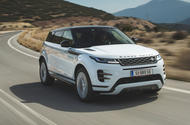Gaydon’s baby Range Rover has matured fast for its second model generation. Remarkably refined, genuinely luxurious – although mid-range petrol power might not suit it best
The second-generation Range Rover Evoque: a car whose length has grown compared with its predecessor by one solitary millimetre. On width, the difference is a relatively profligate four millimetres.Hardly seems worth mentioning, does it? I expand more than that when breathing out – and, come to think of it, I bet even Victoria Beckham does too. On overall height the car has actually shrunk by eleven millimetres over the past eight years (not sure on the comparison to Posh Spice on that score). Compactness matters to the Evoque driver, says Land Rover. Evidently so.So how come this seems like a car that’s mushroomed in size, as if it has become at least one fighting weight classification bigger, if not more? That’s what you’ll be asking yourself while you’re taking in and processing the various particulars of the driving experience of what might be the most important new British-built car due to be introduced in 2019. The Evoque is a compact SUV that’s just taken on many of the dynamic traits of a much bigger one.It’s the result of a telling change of product strategy for Land Rover. Eight years ago this was Gaydon’s catwalk idol. Visual appeal was given such priority for it that there was even a three-door version with a lower, more rakish roofline – which Land Rover, ambitiously but not unreasonably, called a coupé. In the build-up to its launch, the Evoque was openly billed as Land Rover’s TT-rival: its new style icon. Which is precisely how it went on to be embraced by the buying public.That was all before the explosion of the European compact SUV segment, though – something a brand like Land Rover could hardly ignore. The sheer force of competition to be faced by this car today means it must be a more serious, rounded, practical and multi-talented prospect than the car it replaces just to tread water.By convenient coincidence, of course, developing the Evoque in that direction might also help to address one of the criticisms levelled at it over generation one: that it didn’t quite seem, to some, like a proper Range Rover underneath those celebrated designer clothes. Though the second-generation version is still smallish and transverse-engined, and still uses a clutch-based, front-axle-biased four-wheel-drive system, you’d be quite a bit less likely to say that about it, I reckon.
Source: Autocar
